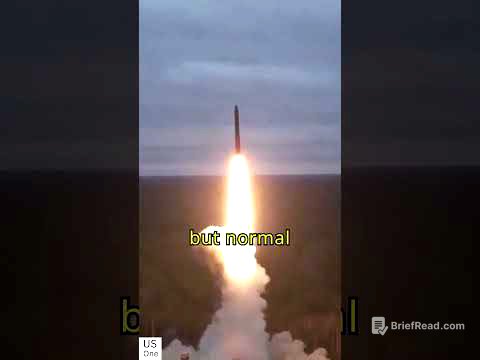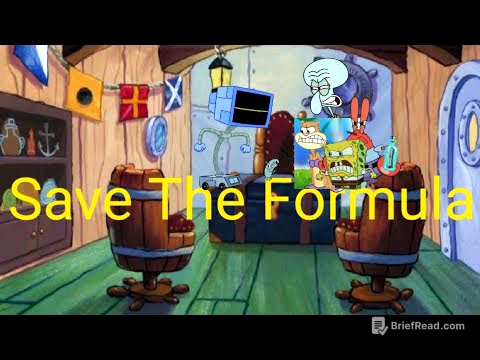TLDR;
This video provides a concise overview of the first chapter of 10th-grade science: Chemical Reactions and Equations. It explains the differences between physical and chemical changes, defines reactants and products, and details how to balance chemical equations using the hit and trial method. The video further explores various types of chemical reactions, including combination, decomposition (thermal, electrolytic, and photolytic), displacement, double displacement, oxidation, and reduction (redox), along with exothermic and endothermic reactions. Finally, it discusses the effects of oxidation in daily life, such as corrosion and rancidity, and methods to prevent them.
- Physical changes are reversible, while chemical changes are irreversible.
- Balancing chemical equations ensures the conservation of mass.
- Oxidation involves the addition of oxygen or removal of hydrogen, while reduction is the opposite.
- Corrosion and rancidity are effects of oxidation in daily life.
Introduction to Chemical Reactions and Equations [0:00]
The video introduces a new series aimed at covering each chapter of science in a short time using animations to help students prepare for board exams. The first chapter to be discussed is "Chemical Reactions and Equations" from the 10th-grade science curriculum.
Physical vs. Chemical Changes [0:40]
The chapter begins with a discussion of changes observed in daily life, distinguishing between physical and chemical changes. Physical changes are reversible, exemplified by the freezing and melting of water. Chemical changes, however, are irreversible, such as the rusting of iron, which results in damage that cannot be undone due to chemical reactions. Physical changes lead to physical reactions, while chemical changes result in chemical reactions.
Reactants and Products in Chemical Reactions [1:35]
A chemical reaction involves reactants, which are substances that participate in the reaction, and products, which are the substances formed. For instance, hydrogen and oxygen combine to form water (H2O). In this reaction, hydrogen and oxygen are the reactants, while water is the product.
Changes During Chemical Reactions [2:35]
During a chemical reaction, several changes can be observed, including changes in the state or color of reactants and products, temperature variations, the release of gas, and the formation of a precipitate.
Understanding Chemical Equations [3:07]
Chemical equations are symbolic representations of chemical reactions, using formulas and symbols. For example, the reaction of carbon and oxygen forming carbon dioxide is represented as C + O2 → CO2. Reactants are written on the left side of the equation, and products are on the right.
Balanced Chemical Equations and the Law of Conservation of Mass [4:10]
A balanced chemical equation has the same number of atoms for each element on both sides (reactants and products). Balancing is necessary to adhere to the law of conservation of mass, which states that mass is neither created nor destroyed in a chemical reaction.
Balancing Chemical Equations: Hit and Trial Method [5:14]
Chemical equations are balanced using the hit and trial method. For example, the reaction of iron with water to form iron oxide and hydrogen (Fe + H2O → Fe3O4 + H2) is unbalanced. To balance it, a table is created listing elements, the number of reactant atoms, and the number of product atoms. Changes are made by multiplying entire compounds, not individual elements within them, to ensure the equation is balanced.
Balancing Example: Iron and Water Reaction [6:17]
To balance the equation Fe + H2O → Fe3O4 + H2, a table is used to track the number of atoms of each element (Fe, H, O) on both sides. Iron is balanced by multiplying Fe by 3. Oxygen is balanced by multiplying H2O by 4, which in turn unbalances hydrogen. Hydrogen is then balanced by multiplying H2 by 4. The balanced equation becomes 3Fe + 4H2O → Fe3O4 + 4H2.
Types of Chemical Reactions: Combination Reaction [8:47]
Chemical reactions are classified into six types. A combination reaction involves two or more reactants combining to form a single product. Examples include the burning of coal (C + O2 → CO2) and the formation of water (2H2 + O2 → 2H2O).
Types of Chemical Reactions: Decomposition Reaction [9:59]
A decomposition reaction involves a single reactant breaking down into two or more products, typically requiring energy. Based on the energy source, decomposition reactions are categorized into thermal, electrolytic, and photolytic decomposition.
Decomposition Reactions: Thermal, Electrolytic, and Photolytic [10:40]
Thermal decomposition occurs with heat, such as calcium carbonate (CaCO3) breaking down into calcium oxide (CaO) and CO2 when heated. Electrolytic decomposition occurs through electricity, like water (H2O) breaking down into hydrogen and oxygen when electricity is passed through it. Photolytic decomposition occurs through sunlight, such as silver chloride breaking down into silver and chlorine when exposed to sunlight.
Types of Chemical Reactions: Displacement Reaction [11:53]
A displacement reaction involves a more reactive element displacing a less reactive element from its compound or solution. For example, zinc reacts with copper sulfate (CuSO4) to form zinc sulfate (ZnSO4) and copper because zinc is more reactive than copper.
Types of Chemical Reactions: Double Displacement Reaction [12:35]
A double displacement reaction involves the exchange of ions or groups of atoms between two reactants. For example, sodium sulfate (Na2SO4) reacts with barium chloride (BaCl2) to form barium sulfate (BaSO4) and sodium chloride (NaCl). These reactions often result in the formation of a precipitate.
Types of Chemical Reactions: Oxidation and Reduction Reactions [14:11]
Oxidation involves the addition of oxygen, removal of hydrogen, or loss of electrons. Reduction is the opposite, involving the removal of oxygen, addition of hydrogen, or gain of electrons.
Oxidation and Reduction Examples and Redox Reactions [14:38]
Examples of oxidation include carbon reacting with oxygen to form carbon dioxide, hydrogen sulfide reacting with oxygen to form water and sulfur, and zinc losing electrons. Examples of reduction include potassium chlorate breaking down, sodium reacting with hydrogen to form sodium hydride, and zinc gaining electrons. When oxidation and reduction occur simultaneously, it is called a redox reaction, such as zinc oxide reacting with carbon to form zinc and carbon monoxide.
Types of Chemical Reactions: Exothermic and Endothermic Reactions [17:36]
Exothermic reactions release heat, such as the burning of natural gas (methane) in oxygen to form CO2 and water. Endothermic reactions absorb heat, such as mercury oxide breaking down into mercury and oxygen, and photosynthesis, which absorbs the sun's heat energy.
Effects of Oxidation in Daily Life: Corrosion [18:43]
Oxidation's effects in daily life include corrosion and rancidity. Corrosion is the deterioration of a metal surface due to reactions with air, water, or chemicals. Examples include the black coating on silver, the green layer on copper, and rust on iron. Corrosion can be prevented by painting iron objects, cleaning silver regularly, and using a paste of baking soda and salt to clean copper.
Effects of Oxidation in Daily Life: Rancidity [20:42]
Rancidity is the slow oxidation of food materials containing oil and fat, spoiling their taste and smell. It can be prevented by keeping food in airtight containers, away from direct sunlight, at low temperatures in the refrigerator, and by adding antioxidants. Chips are filled with nitrogen gas to prevent rancidity by protecting them from oxidation.









